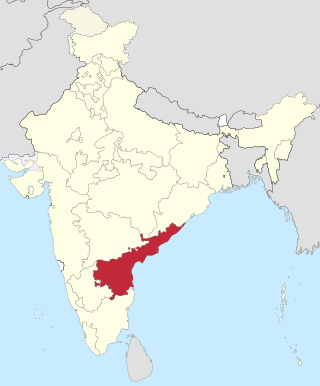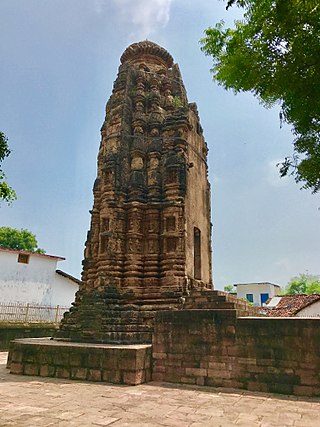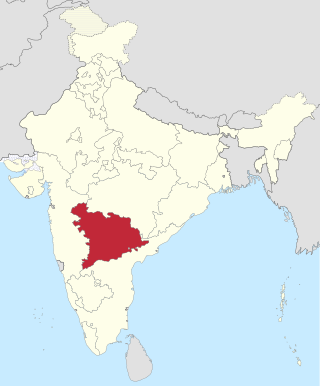
A capital city or just capital is the municipality holding primary status in a country, state, province, department, or other subnational division, usually as its seat of the government. A capital is typically a city that physically encompasses the government's offices and meeting places; the status as capital is often designated by its law or constitution. In some jurisdictions, including several countries, different branches of government are in different settlements, sometimes meaning multiple official capitals. In some cases, a distinction is made between the official (constitutional) capital and the seat of government, which is in another place.

India is a federal republic comprising 28 states and 8 union territories. The states and union territories are further subdivided into districts and smaller administrative divisions.
The Indian Republic held its first elections in 1951–52.

Mysore State, colloquially Old Mysore, was a political territory within the Dominion of India and the subsequent Republic of India from 1947 until 1956. The state was formed by renaming the Kingdom of Mysore, and Bangalore replaced Mysore as the state's capital. When Parliament passed the States Reorganisation Act in 1956, Mysore State was considerably enlarged when it became a linguistically homogeneous Kannada-speaking state within the Republic of India by incorporating territories from Andhra, Bombay, Coorg, Hyderabad, and Madras States, as well as other petty fiefdoms. It was subsequently renamed Karnataka in 1973.

Potti Sreeramulu, was an Indian freedom fighter and revolutionary. Sreeramulu is revered as Amarajeevi in the Andhra region for his self-sacrifice for the Andhra cause. He became famous for undertaking a hunger strike for 56 days in support of having separate state for Andhra Pradesh; he died in the process. His death sparked public rioting and Indian Prime Minister Jawaharlal Nehru declared the intent by the newly liberated nation to form Andhra State three days following the death of Sreeramulu. He contributed his life for the formation of a separate Telugu-speaking state from the dominant Tamil-speaking Madras presidency. His struggles led to the formation of separate Telugu-speaking state called "Andhra state".
The high courts of India are the highest courts of appellate jurisdiction in each state and union territory of India. However, a high court exercises its original civil and criminal jurisdiction only if the subordinate courts are not authorized by law to try such matters for lack of peculiar or territorial jurisdiction. High courts may also enjoy original jurisdiction in certain matters, if so designated, especially by the constitution, a state law or union law.

Andhra State was a state in India created in 1953 from the Telugu-speaking northern districts of Madras State. The state was made up of this two distinct cultural regions – Rayalaseema and Coastal Andhra. Andhra State did not include all Telugu-speaking areas, as it excluded some in Hyderabad State. Under the State Reorganisation Act of 1956, Andhra State was merged with the Telugu-speaking regions of Hyderabad State to form Andhra Pradesh.
The administrative divisions of India are subnational administrative units of India; they are composed of a nested hierarchy of administrative divisions.

The constitutional power to create new states and union territories in India is solely reserved with the Parliament of India, which can do so by announcing new states/union territories, separating territory from an existing state or merging two or more states/union territories or parts of them. As of 2024, there are 28 states and eight union territories in India.

Arang, also known as "The town of temples" of Chhattisgarh, is a block and a Nagar Palika in Raipur District in the state of Chhattisgarh, India. It is situated near the eastern limits of Raipur City and close to Mahasamund City. Arang is an ancient town, which was ruled by the Haihayas Rajput dynasty. It is famous for its many Jain and Hindu temples which belong to the 11th and 12th centuries; these are the Mand Deval Jain temple, the Mahamaya temple, the Panchmukhi temple and the Hanuman temple. Due to the Archaeological finds of a copper plate inscription dated to the Gupta Empire, known as the Arang Plate of Bhimasena II of the clan of Rajarsitulya, has established the town's ancient history as a Hindu and Jain religious centre, which was then under the rule of Hindu kings. The Mand Deval Jain temple is the most ancient of these temples dated to the 11th century where three huge images of Digambara tirthankaras are deified in the sanctum sanctorum; these are carved in black stone and polished.

The recorded history of Andhra Pradesh, one of the 28 states of 21st-century India, begins in the Vedic period. It is mentioned in Sanskrit epics such as the Aitareya Brahmana. Its sixth-century BCE incarnation Assaka lay between the Godavari and Krishna Rivers, one of sixteen mahajanapadas. The Satavahanas succeeded them, built Amaravati, and reached a zenith under Gautamiputra Satakarni.
The States Reorganisation Commission (SRC) constituted by the Central Government of India in December 1953 to recommend the reorganization of state boundaries. In September 1955, after two years of study, the Commission, comprising Justice Fazal Ali, K. M. Panikkar and H. N. Kunzru, submitted its report. The commission's recommendations were accepted with some modifications and implemented in the States Reorganisation Act in November, 1956. The act provided that India's state boundaries should be reorganized to form 14 states and 6 centrally administered territories. On December 10, 1948, the report of Dar Commission was published but the issue remained unsolved.
A tehsil is a local unit of administrative division in India and Pakistan. It is a subdistrict of the area within a district including the designated populated place that serves as its administrative centre, with possible additional towns, and usually a number of villages. The terms in India have replaced earlier terms, such as pargana (pergunnah) and thana.
The Madras Public Libraries Act, subsequently renamed as the Tamil Nadu Public Libraries Act, was enacted in Madras State, India, in 1948. The act was the first of its kind to be enacted in India after independence. The Connemara Public Library became the first library to come under the purview of this act, as a "State central library". Subsequently, nine district libraries were added during the Five year plan from 1951. The act was enacted based on research and activity by S. R. Ranganathan and the Madras Library Association. Other states have enacted public library acts modelled on the Madras Public Libraries Act.

Hyderabad State was a state in Dominion and later Republic of India, formed after the accession of the State of Hyderabad into the Union on 17 September 1948. It existed from 1948 to 1956.

The States Reorganisation Act, 1956 was a major reform of the boundaries of India's states and territories, organising them along linguistic lines.
The Andhra Pradesh Decentralisation and Inclusive Development of All Regions Act, 2020 is an act of Andhra Pradesh Legislature aimed at the decentralisation of governance in the Indian state of Andhra Pradesh. The bill was proposed by the Government of Andhra Pradesh to establish three capitals at different places in the state namely Visakhapatnam, Amaravati, and Kurnool, which will serve as executive, legislative and judicial capitals respectively.










